I support an older c++ v100 security system. Most of the xml stored in the database in a byte array (blob data), is easy enough to decrypt with UTF-8. However, we have a couple places where I have been unable to figure out how to decrypt the byte array to anything useful, using C# 4.7. After some studying of the data yesterday, it was determined that the data uses some form of encoding called 'UCS-2 LE BOM'.
I almost have to assume this is some form of Unicode... but I have yet to get that binary array to decrypt to anything decipherable.
If you have any sort of example code that would me the readable string, it would be most appreciated.
Thus far I have tried all forms of encoding offered in C#, but the results are all cryptic.
The xml stored in each record, is like this:
<COMMAND_BLOCK>
<COMMAND Workstation='{Workstation}' Source="ServiceManager" Target="{Unit:|SELECT DISTINCT [Name],[Address] FROM [MasterControllers] WHERE [Address] LIKE '{Workstation}.R%'}" Command="50001"/>
</COMMAND_BLOCK>
I am currently only trying to get the stored byte array to be a string. Once it is a string, I'll be fine with it. I've tried the following:
var xml = Encoding.UTF8.GetString(_commandObjectList[i].ImageData);
var xml2 = Encoding.UTF32.GetString(_commandObjectList[i].ImageData);
var xml3 = Encoding.Unicode.GetString(_commandObjectList[i].ImageData);
var xml4 = Encoding.ASCII.GetString(_commandObjectList[i].ImageData);
var xml5 = Encoding.BigEndianUnicode.GetString(_commandObjectList[i].ImageData);
var xml6 = Encoding.Default.GetString(_commandObjectList[i].ImageData);
var xml7 = Encoding.UTF7.GetString(_commandObjectList[i].ImageData);
Raw blob data stored in Sql Server Table: 0xFFFE3C0043004F004D004D0041004E0044005F0042004C004F0043004B003E0020000D000A003C0043004F004D004D0041004E004400200057006F0072006B00730074006100740069006F006E003D0027007B0057006F0072006B00730074006100740069006F006E007D002700200053006F0075007200630065003D00220053006500720076006900630065004D0061006E006100670065007200220020005400610072006700650074003D0022007B0055006E00690074003A007C00530045004C004500430054002000440049005300540049004E004300540020005B004E0061006D0065005D002C005B0041006400640072006500730073005D002000460052004F004D0020005B004D006100730074006500720043006F006E00740072006F006C006C006500720073005D0020005700480045005200450020005B0041006400640072006500730073005D0020004C0049004B004500200027007B0057006F0072006B00730074006100740069006F006E007D002E005200250027007D002200200043006F006D006D0061006E0064003D0022003500300030003200370022002F003E000D000A003C002F0043004F004D004D0041004E0044005F0042004C004F0043004B003E000D000A000000
The C++ code that encodes and decodes the xml into/from the database, is CFile, located in 'C:\Program Files (x86)\Microsoft Visual Studio 10.0\VC\atlmfc\include\afx.h'. C++ code used for encode/decode:
CFile fileXML;
if(fileXML.Open(dlg.m_strFileName, CFile::modeCreate|CFile::modeWrite))
{
fileXML.Write(dlg.m_strCommand,dlg.m_strCommand.GetLength());
fileXML.Close();
}
